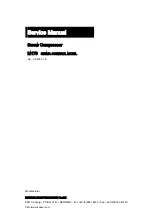
MAINTENANCE /
REP
AIR
TROUBLESHOOTING
OPERA
TION
ASSEMBL
Y /
INST
ALLA
TION
SAFETY /
SPECIFICA
TIONS
GETTING ST
AR
TED
10
OPERATION
Before Each Start-up
Operating Procedure
1. Turn regulator knob fully counter clockwise (to the left) to close air flow.
2. Connect air hose to outlet of regulator.
3. Turn ON/OFF Switch to OFF position.
4. Plug in power cord.
5. Turn ON/OFF Switch to ON position and let compressor run until it reaches automatic shutoff pressure.
6. Attach tire chuck or tool to end of hose.
7. Adjust regulator to proper pressure for tool or tire. Operate tool per instructions.
As air is depleted from the tank by use of a tire chuck, tool, etc., the compressor will restart automatically
at its preset “cut-in” pressure. When a tool is being used continuously, the compressor will cycle on and off
automatically.
8. Turn switch to OFF position, unplug power cord and drain tank.
MAINTENANCE
The compressor should be checked often for any visible problems and the following maintenance
procedures should be performed each time the compressor is used.
ASME Safety Valve
1. Turn the air compressor on and allow the tank
to fill. The compressor will shut off when the
pressure reaches the preset maximum.
2. Turn the air compressor off.
3. Pull the ring on the safety valve to release the
air for several seconds. ALWAYS use your hand
to deflect fast-moving air past your face.
4. Release the ring. Air will stop escaping when the
ring is released at approximately 40 PSI - 60 PSI.
5. If air leaks after the ring has been released, or
if the valve is stuck and cannotbe actuarted bu
the ring, remove the unit from service. DO NOT
use the air compressor until the safety valve has
been replaced. Use of the air compressor in this condition could result in death or serious bodily injury.
Figure 3
MOISTURE IN COMPRESSED AIR
Moisture in compressed air will form into droplets as it comes from an air compressor pump. When
humidity is high or when a compressor is in continuous use for an extended period of time, this
moisture will collect in the tank. When using a paint spray or sandblast gun, this water will be carried
from the tank through the hose, and out of the gun as droplets mixed with the spray material.
IMPORTANT:
This condensation will cause water spots in a paint job, especially when spraying other
than water based paints. If sandblasting, it will cause the sand to cake and clog the gun, rendering
it ineffective. A filter in the air line, located as near to the gun as possible, will help eliminate this
moisture.
Disconnect power source then release all pressure from the system before attempting to install, service, relocate or
perform any maintenance. Service should be performed by an authorized service representative.
Wear safety glasses. Check the safety valve by performing the following steps:
Safety valve must be replaced if it cannot be actuated or it leaks air after ring is released.













































